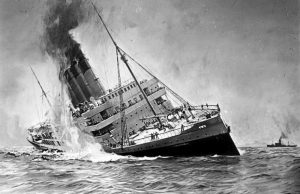 On January 31, 1917, at the height of World War I, Germany announced that they would renew the use of unrestricted submarine warfare in the Atlantic Ocean. The German torpedo-armed submarines, known as U-Boats, prepared to attack any and all ships operating in the Atlantic, including civilian passenger carriers, which were said to have been sighted in war-zone waters. They were prepared to attack without a second thought, whether they were innocent civilians or not. Unleashing the U-Boats was almost like unleashing terrorists, because the U-Boats were an invisible enemy. Yes, the could be seen, but beneath the surface of the water, they could easily hide in the murky darkness, unleashing their torpedoes to go streaking through the water. The first sign of danger was when the doomed ship watchmen saw the dreaded white streak coming at them through the water. There was no time to take evasive action. The ship could not move that fast, and it could not turn on a dime. They were sitting ducks.
On January 31, 1917, at the height of World War I, Germany announced that they would renew the use of unrestricted submarine warfare in the Atlantic Ocean. The German torpedo-armed submarines, known as U-Boats, prepared to attack any and all ships operating in the Atlantic, including civilian passenger carriers, which were said to have been sighted in war-zone waters. They were prepared to attack without a second thought, whether they were innocent civilians or not. Unleashing the U-Boats was almost like unleashing terrorists, because the U-Boats were an invisible enemy. Yes, the could be seen, but beneath the surface of the water, they could easily hide in the murky darkness, unleashing their torpedoes to go streaking through the water. The first sign of danger was when the doomed ship watchmen saw the dreaded white streak coming at them through the water. There was no time to take evasive action. The ship could not move that fast, and it could not turn on a dime. They were sitting ducks.
The vast majority of people of the United States favored neutrality when it came to World War I. So when the war erupted in 1914, President Woodrow Wilson pledged the stay neutral. The problem was that Britain was one of America’s closest trading partners. That created serious tension between the United States and Germany, when Germany attempted a blockade of the British isles. Several US ships traveling to Britain were damaged or sunk by German mines and, in February 1915, Germany announced unrestricted warfare against all ships, neutral or otherwise, that entered the war zone around Britain. One month later, Germany announced that a German cruiser had sunk the William P. Frye, a private American merchant vessel that was transporting grain to England when it disappeared. President Wilson was outraged, but the German government apologized, calling the attack an unfortunate mistake. That didn’t stop their reign of terror, however. In November they sank an Italian liner without warning, killing 272 people, including 27 Americans. Public opinion concerning the war, and the stand of the United States in it began to change. It was time for the United States to get into World War I.
The Germans were far in advance of other nations when it came to submarines. The U-boat was 214 feet long, carried 35 men and 12 torpedoes, and could travel underwater for two hours at a time. In the first few years of World War I, the U-boats took a terrible toll on Allied shipping. In early May 1915, several New York newspapers had to publish a warning by the German embassy in Washington that Americans traveling on British or Allied ships in war zones did so at their own risk. The announcement was placed on the same page as an advertisement for the imminent sailing of the British-owned Lusitania ocean liner from New York to Liverpool. I’m sure they had hoped that people would heed the warning, but many people boarding the Lusitania either didn’t take notice of the warning or they didn’t see it. On May 7, the Lusitania was torpedoed without warning just off the coast of Ireland. Of the 1,959 passengers, 1,198 were killed, including 128 Americans. The Germans had proven once again that they were ruthless and conniving. Following the sinking of the Lusitania The German government accused the Lusitania was carrying munitions. The US demanded an end to German attacks on unarmed passenger and merchant ships, and full repayment for the loss.
Following the sinking of the Lusitania the German government accused the Lusitania was carrying munitions. The US demanded an end to German attacks on unarmed passenger and merchant ships, and full repayment for the loss. Germany countered with a pledge to see to the safety of passengers before sinking unarmed vessels in August 1915. All that changed by January 1917, when Germany, determined to win its war of attrition against the Allies, announced the resumption of unrestricted warfare. Three days later, the United States broke off diplomatic relations with Germany, who, just hours later sunk the American liner Housatonic. None of the 25 Americans on board were killed and they were picked up by a British steamer.
On February 22, Congress passed a $250 million arms-appropriations bill intended to ready the United States for war. British authorities gave the US ambassador to Britain a copy of what has become known as the “Zimmermann Note,” a coded message from German Foreign Secretary Arthur Zimmermann to Count Johann von Bernstorff, the German ambassador to Mexico. In the telegram, intercepted and deciphered by British intelligence, Zimmermann stated that, in the event of war with the United States, Mexico should be asked to  enter the conflict as a German ally. In return, Germany would promise to restore to Mexico the lost territories of Texas, New Mexico and Arizona. On March 1, the outraged US State Department published the note and America was galvanized against Germany once and for all. In late March, Germany sank four more US merchant ships. President Wilson appeared before Congress and called for a declaration of war against Germany on April 2nd. On April 4th, the Senate voted 82 to six to declare war against Germany. Two days later, the House of Representatives endorsed the declaration by a vote of 373 to 50 and America formally entered World War I. They were after that invisible enemy, and they were determined to find it and destroy it.
enter the conflict as a German ally. In return, Germany would promise to restore to Mexico the lost territories of Texas, New Mexico and Arizona. On March 1, the outraged US State Department published the note and America was galvanized against Germany once and for all. In late March, Germany sank four more US merchant ships. President Wilson appeared before Congress and called for a declaration of war against Germany on April 2nd. On April 4th, the Senate voted 82 to six to declare war against Germany. Two days later, the House of Representatives endorsed the declaration by a vote of 373 to 50 and America formally entered World War I. They were after that invisible enemy, and they were determined to find it and destroy it.


Leave a Reply